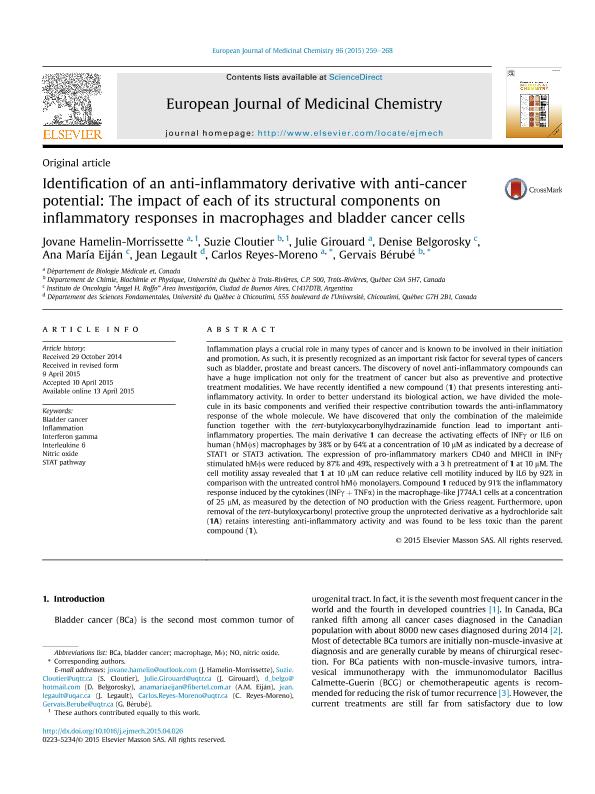Mostrar el registro sencillo del ítem
dc.contributor.author
Hamelin Morrissette, Jovane
dc.contributor.author
Cloutier, Suzie
dc.contributor.author
Girouard, Julie
dc.contributor.author
Belgorosky, Denise

dc.contributor.author
Eijan, Ana Maria

dc.contributor.author
Legault, Jean
dc.contributor.author
Reyes Moreno, Carlos
dc.contributor.author
Bérubé, Gervais
dc.date.available
2017-05-02T19:26:15Z
dc.date.issued
2015-05-26
dc.identifier.citation
Hamelin Morrissette, Jovane; Cloutier, Suzie; Girouard, Julie; Belgorosky, Denise; Eijan, Ana Maria; et al.; Identification of an anti-inflammatory derivative with anti-cancer potential: the impact of each of its structural components on inflammatory responses in macrophages and bladder cancer cells; Elsevier Masson; European Journal of Medical Chemistry; 96; 26-5-2015; 259-268
dc.identifier.issn
0223-5234
dc.identifier.uri
http://hdl.handle.net/11336/15894
dc.description.abstract
Inflammation plays a crucial role in many types of cancer and is known to be involved in their initiation and promotion. As such, it is presently recognized as an important risk factor for several types of cancers such as bladder, prostate and breast cancers. The discovery of novel anti-inflammatory compounds can have a huge implication not only for the treatment of cancer but also as preventive and protective treatment modalities. We have recently identified a new compound (1) that presents interesting anti-inflammatory activity. In order to better understand its biological action, we have divided the molecule in its basic components and verified their respective contribution towards the anti-inflammatory response of the whole molecule. We have discovered that only the combination of the maleimide function together with the tert-butyloxycarbonylhydrazinamide function lead to important anti-inflammatory properties. The main derivative 1 can decrease the activating effects of INFγ or IL6 on human (hMϕs) macrophages by 38% or by 64% at a concentration of 10 μM as indicated by a decrease of STAT1 or STAT3 activation. The expression of pro-inflammatory markers CD40 and MHCII in INFγ stimulated hMϕs were reduced by 87% and 49%, respectively with a 3 h pretreatment of 1 at 10 μM. The cell motility assay revealed that 1 at 10 μM can reduce relative cell motility induced by IL6 by 92% in comparison with the untreated control hMϕ monolayers. Compound 1 reduced by 91% the inflammatory response induced by the cytokines (INFγ + TNFα) in the macrophage-like J774A.1 cells at a concentration of 25 μM, as measured by the detection of NO production with the Griess reagent. Furthermore, upon removal of the tert-butyloxycarbonyl protective group the unprotected derivative as a hydrochloride salt (1A) retains interesting anti-inflammatory activity and was found to be less toxic than the parent compound (1).
dc.format
application/pdf
dc.language.iso
eng
dc.publisher
Elsevier Masson

dc.rights
info:eu-repo/semantics/openAccess
dc.rights.uri
https://creativecommons.org/licenses/by-nc-nd/2.5/ar/
dc.subject
Bladder Cancer
dc.subject
Inflammation
dc.subject
Interferon Gamma
dc.subject
Interleukine 6
dc.subject
Nitric Oxide
dc.subject
Stat Pathway
dc.subject.classification
Biotecnología relacionada con la Salud

dc.subject.classification
Biotecnología de la Salud

dc.subject.classification
CIENCIAS MÉDICAS Y DE LA SALUD

dc.title
Identification of an anti-inflammatory derivative with anti-cancer potential: the impact of each of its structural components on inflammatory responses in macrophages and bladder cancer cells
dc.type
info:eu-repo/semantics/article
dc.type
info:ar-repo/semantics/artículo
dc.type
info:eu-repo/semantics/publishedVersion
dc.date.updated
2017-04-28T17:10:23Z
dc.journal.volume
96
dc.journal.pagination
259-268
dc.journal.pais
Francia

dc.journal.ciudad
París
dc.description.fil
Fil: Hamelin Morrissette, Jovane. Université du Québec à Trois-Rivières; Canadá
dc.description.fil
Fil: Cloutier, Suzie. Université du Québec à Trois-Rivières; Canadá
dc.description.fil
Fil: Girouard, Julie. Université du Québec à Trois-Rivières; Canadá
dc.description.fil
Fil: Belgorosky, Denise. Universidad de Buenos Aires. Facultad de Medicina. Instituto de Oncología "Ángel H. Roffo"; Argentina. Consejo Nacional de Investigaciones Científicas y Técnicas; Argentina
dc.description.fil
Fil: Eijan, Ana Maria. Universidad de Buenos Aires. Facultad de Medicina. Instituto de Oncología "Ángel H. Roffo"; Argentina. Consejo Nacional de Investigaciones Científicas y Técnicas; Argentina
dc.description.fil
Fil: Legault, Jean. Université du Québec à Chicoutimi; Canadá
dc.description.fil
Fil: Reyes Moreno, Carlos. Université du Québec à Trois-Rivières; Canadá
dc.description.fil
Fil: Bérubé, Gervais. Université du Québec à Trois-Rivières; Canadá
dc.journal.title
European Journal of Medical Chemistry

dc.relation.alternativeid
info:eu-repo/semantics/altIdentifier/doi/http://dx.doi.org/10.1016/j.ejmech.2015.04.026
dc.relation.alternativeid
info:eu-repo/semantics/altIdentifier/url/http://www.sciencedirect.com/science/article/pii/S0223523415002858
Archivos asociados
